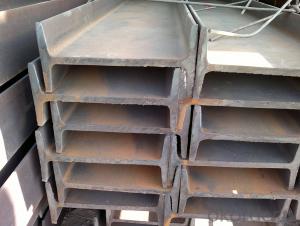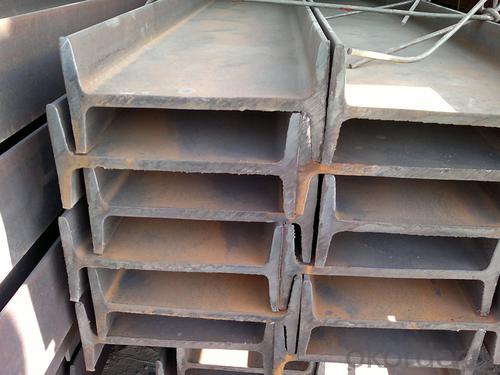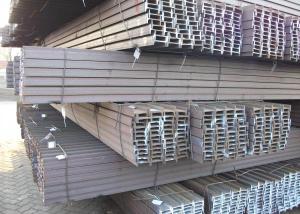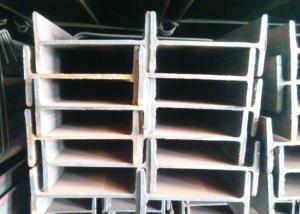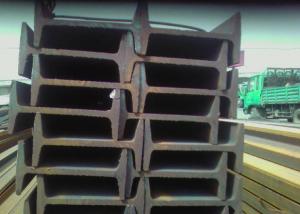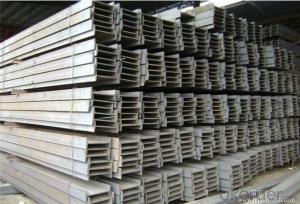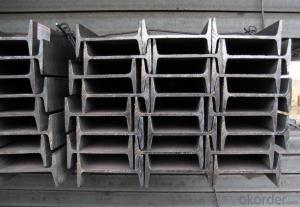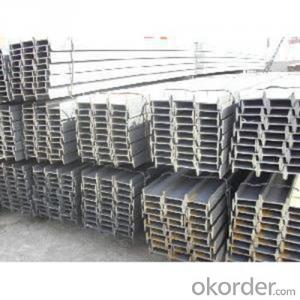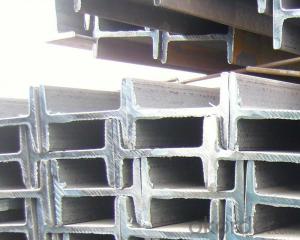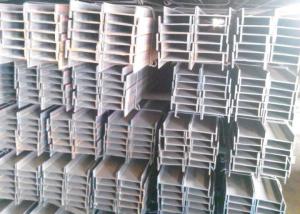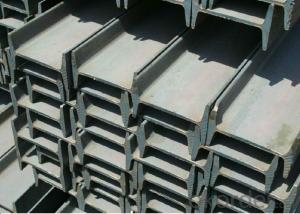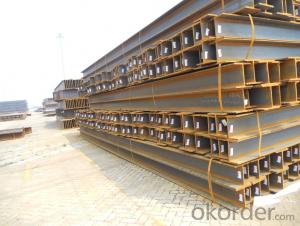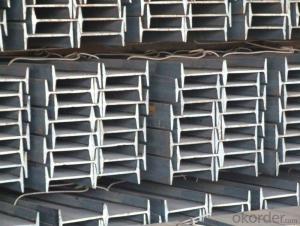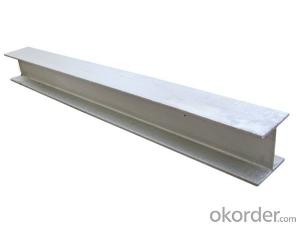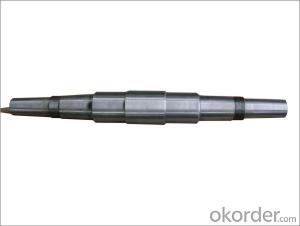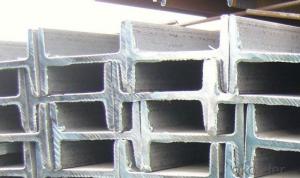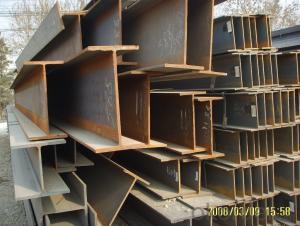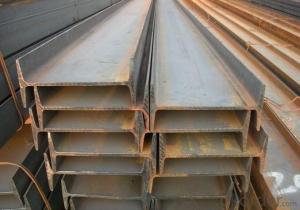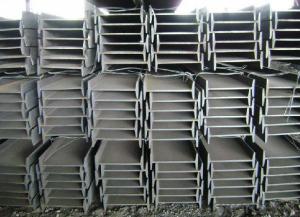Hot Rolled Steel I Beams for support structrue
- Loading Port:
- Tianjin
- Payment Terms:
- TT OR LC
- Min Order Qty:
- 10000 m.t
- Supply Capability:
- 250000 m.t/month
OKorder Service Pledge
OKorder Financial Service
You Might Also Like
Specification
Product Description:
OKorder is offering Hot Rolled Steel I Beams for support structrue at great prices with worldwide shipping. Our supplier is a world-class manufacturer of steel, with our products utilized the world over. OKorder annually supplies products to European and Asian markets. We provide quotations within 24 hours of receiving an inquiry and guarantee competitive prices.
Product Applications:
Hot Rolled Steel I Beams for support structrue are widely used in various construction structures, bridges, autos, brackets, mechanisms and so on.
Product Advantages:
OKorder's Hot Rolled Steel I Beams for support structrue are durable, strong, and resist corrosion.
Main Product Features:
· Premium quality
· Prompt delivery & seaworthy packing (30 days after receiving deposit)
· Corrosion resistance
· Can be recycled and reused
· Mill test certification
· Professional Service
· Competitive pricing
Product Specifications:
1. Product name: Hot Rolled Steel I Beams for support structrue
2. Standard: EN10025, GB Standard, etc.
3. Grade: Q235B, A36, Q345, SS400 or other equivalent.
4. Length: 5.8M, 6M, 9M, 10M, 12M or as your requirements
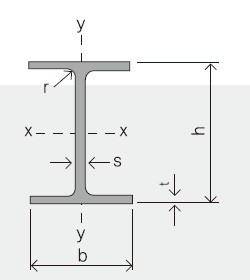
Section | Standard Sectional Dimensions(mm) | ||||
h | b | s | t | Mass Kg/m | |
IPE80 | 80 | 46 | 3.80 | 5.20 | 6.00 |
IPE100 | 100 | 55 | 4.10 | 5.70 | 8.10 |
IPE120 | 120 | 64 | 4.80 | 6.30 | 10.40 |
IPE140 | 140 | 73 | 4.70 | 6.90 | 12.90 |
IPE160 | 160 | 82 | 5.00 | 7.40 | 15.80 |
IPE180 | 180 | 91 | 5.30 | 8.00 | 18.80 |
IPE200 | 200 | 100 | 5.60 | 8.50 | 22.40 |
IPE220 | 220 | 110 | 5.90 | 9.20 | 26.20 |
IPE240 | 240 | 120 | 6.20 | 9.80 | 30.70 |
IPE270 | 270 | 135 | 6.60 | 10.20 | 36.10 |
IPEAA80 | 80 | 46 | 3.20 | 4.20 | 4.95 |
IPEAA100 | 100 | 55 | 3.60 | 4.50 | 6.72 |
IPEAA120 | 120 | 64 | 3.80 | 4.80 | 8.36 |
IPEAA140 | 140 | 73 | 3.80 | 5.20 | 10.05 |
IPEAA160 | 160 | 82 | 4.00 | 5.60 | 12.31 |
IPEAA180 | 180 | 91 | 4.30 | 6.50 | 15.40 |
IPEAA200 | 200 | 100 | 4.50 | 6.70 | 17.95 |
5.Color marking: There will be color marking on both end of the bundle for the cargo delivered by bulk vessel. That makes it easily to distinguish at the destination port.
Tag mark: there will be tag mark tied up on the bundles. The information usually including supplier logo and name, product name, made in China, shipping marks and other information request by the customer.
If loading by container the marking is not needed, but we will prepare it as customer request.
6. Shipment: In containers or in bulk cargo
FAQ:
Q1: Why buy Hot Rolled Steel I Beams for Construction from China from OKorder.com?
A1: All products are carefully selected from China's most reliable manufacturing enterprises. Through its ISO certifications, OKorder.com adheres to the highest standards and a commitment to supply chain safety and customer satisfaction. We can guarantee the quality!
Q2: The products are invoicing on theoretical weight or on actual weight?
A2: We can do it in both manners, it’s according to buyer's requirement.
Images:
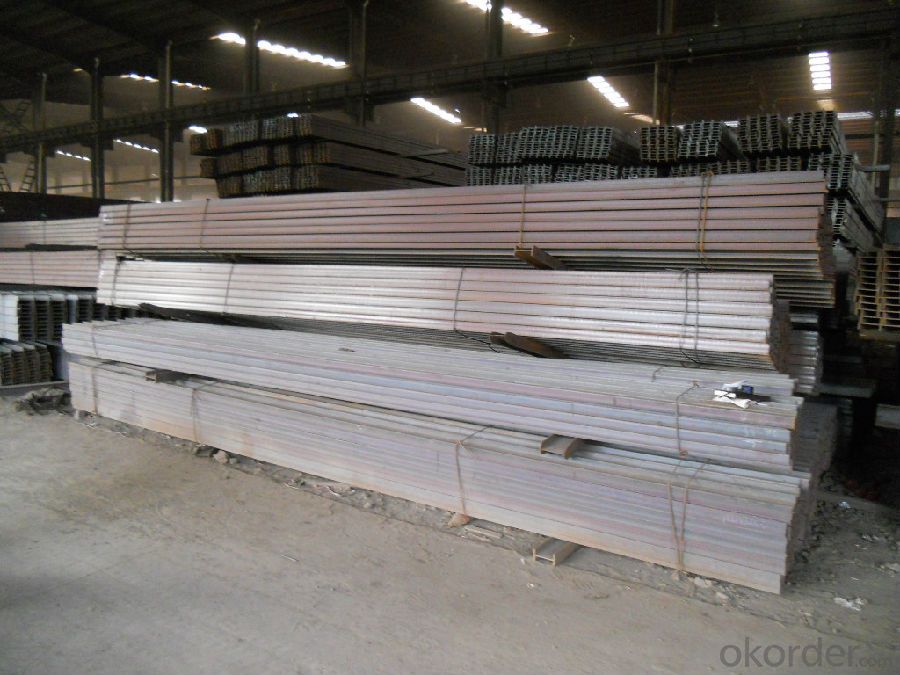
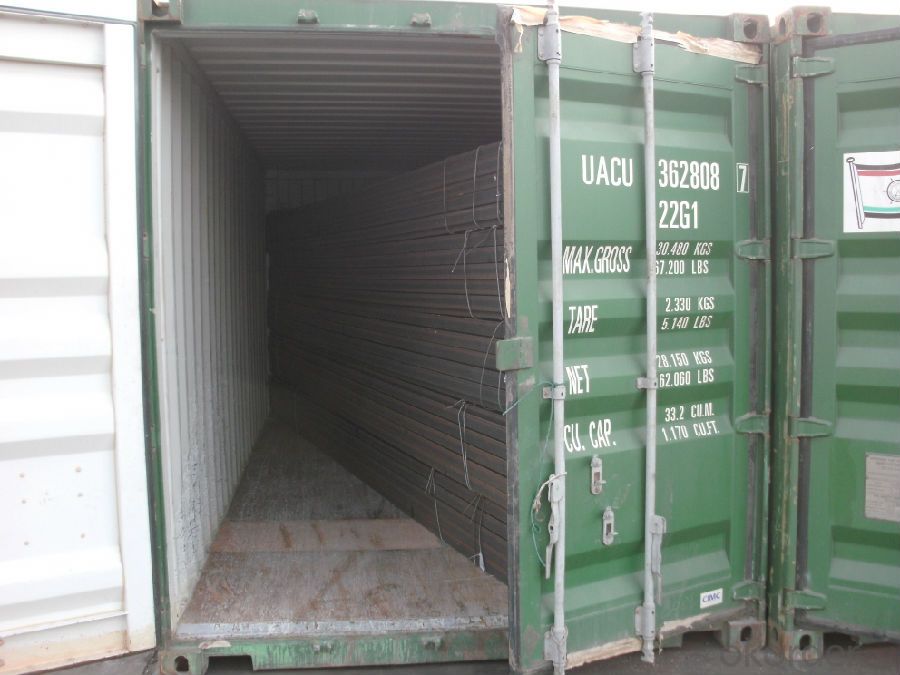
- Q: Can steel I-beams be used in seismic or high-wind areas?
- Indeed, seismic or high-wind areas can accommodate the utilization of steel I-beams. Steel, being an exceptionally durable and robust material, is well-suited to endure the forces produced by earthquakes or powerful winds. In seismic regions, steel I-beams are deliberately engineered to possess sufficient ductility and flexibility to assimilate and dissipate the energy generated during an earthquake, thereby guaranteeing the stability of the structure. Similarly, in high-wind areas, steel I-beams can be designed to withstand the lateral forces unleashed by strong winds, thereby averting structural collapse or damage. Furthermore, steel I-beams can be customized to adhere to specific building codes and standards applicable to seismic or high-wind areas, thus ensuring the safety and stability of the structure.
- Q: Can steel I-beams be customized or fabricated to specific project requirements?
- Yes, steel I-beams can be customized or fabricated to specific project requirements. Steel fabricators have the ability to design and produce I-beams according to the needs of a particular project. This customization may include adjusting the dimensions, such as height, width, and length, to fit specific structural requirements. Additionally, fabricators can modify the material thickness and type, such as using high-strength steel, to enhance the beams' load-bearing capabilities. Furthermore, customization can extend to the fabrication process itself, including drilling holes, welding additional components, or applying protective coatings to meet project-specific needs. Overall, steel I-beams offer great versatility and can be tailored to suit a wide range of project requirements.
- Q: Are there any limitations to the length of steel I-beams?
- Yes, there are limitations to the length of steel I-beams. The length of steel I-beams is limited by various factors, including manufacturing capabilities, transportation logistics, and structural considerations. In terms of manufacturing capabilities, the size and length of steel I-beams that can be produced are limited by the capacity of the steel mills and fabrication facilities. These facilities have specific equipment and processes in place, which may restrict the maximum length that can be produced efficiently and cost-effectively. Transportation logistics also play a crucial role in limiting the length of steel I-beams. Due to their size and weight, longer beams may be challenging to transport from the manufacturing facility to the construction site. Factors such as road and bridge weight restrictions, transportation infrastructure limitations, and the availability of specialized equipment for handling and transporting long beams can further restrict their length. Structural considerations are another important limitation. The longer the steel I-beam, the greater the risk of deflection or bending under load. Beyond a certain length, the beam's structural integrity may be compromised, leading to potential safety concerns. Structural engineers and architects must carefully analyze the load-bearing requirements of a particular project and determine the maximum allowable length for steel I-beams based on factors such as load distribution, beam design, and support systems. In summary, while steel I-beams can be manufactured in various lengths, there are limitations imposed by manufacturing capabilities, transportation logistics, and structural considerations. It is essential to work with professionals in the industry to ensure that the length of steel I-beams used in construction projects adheres to these limitations while meeting the required design standards and safety regulations.
- Q: What are the common design considerations when using steel I-beams?
- When using steel I-beams in construction or engineering projects, there are several common design considerations that need to be taken into account. These considerations include: 1. Load capacity: One of the most important design considerations when using steel I-beams is determining the load capacity they can safely support. This involves calculating the dead load (weight of the structure itself) and the live load (weight of the occupants, furniture, and other moving loads) that will be imposed on the beams. 2. Span length: The length of the span or distance between supports is another crucial consideration. Longer spans require beefier steel I-beams to ensure structural integrity and prevent excessive deflection or sagging. 3. Deflection: Deflection refers to the amount of bending or flexing that occurs in a steel I-beam under load. It is important to limit deflection within acceptable limits to maintain the structural stability and prevent any noticeable deformations. 4. Connection details: The design of connections between steel I-beams and other structural elements, such as columns or beams, is critical for ensuring proper load transfer and overall stability. Various connection methods, such as welding, bolting, or using steel plates, need to be carefully considered and designed. 5. Fire protection: Steel can lose strength and structural integrity when exposed to high temperatures. Therefore, fire protection measures, such as fire-resistant coatings or encasement with fire-rated materials, should be incorporated into the design to maintain the steel I-beams' performance in case of a fire. 6. Camber: Steel I-beams may be cambered or curved slightly upward to compensate for the deflection that will occur when the dead and live loads are applied. This helps to achieve a level final appearance and minimize any perception of sagging. 7. Material selection: Different grades of steel are available, each with its own strength and durability characteristics. The appropriate material selection should consider factors such as anticipated loads, environmental conditions, and cost-effectiveness. 8. Design codes and regulations: Compliance with relevant design codes and regulations is crucial to ensure the safety and longevity of the structure. These codes provide guidelines for factors such as beam sizes, load calculations, connection details, and fire protection requirements. By considering these design considerations, engineers and designers can effectively utilize steel I-beams to create strong, durable, and safe structures that meet the specific requirements of their projects.
- Q: How do steel I-beams perform in areas with high seismic activity?
- Steel I-beams are widely recognized for their excellent performance in areas with high seismic activity. The combination of their structural properties and inherent strength makes them highly suitable for withstanding earthquakes and other seismic events. Firstly, steel I-beams have a high strength-to-weight ratio, which means they can withstand significant loads without being excessively heavy. This characteristic is especially crucial in seismic zones, as it allows structures to be designed with the necessary strength while minimizing their overall weight. The lighter the structure, the lower the seismic forces it will experience during an earthquake. Moreover, steel I-beams possess excellent ductility, which is the ability to deform under stress without losing their overall strength. When subjected to a seismic event, these beams can absorb and dissipate seismic energy through controlled yielding and plastic deformation. This ductile behavior helps prevent catastrophic failure by allowing the structure to flex and absorb the forces generated by the earthquake, effectively reducing the risk of collapse. Additionally, steel has a high tensile strength, meaning it can resist pulling forces. This property is particularly advantageous during seismic events, as it helps the I-beams resist the lateral forces and ground motion generated by earthquakes. Steel's ability to distribute these forces throughout the structure helps minimize localized damage and ensures the overall stability of the building. Furthermore, steel I-beams can be easily reinforced or retrofitted to enhance their performance in high seismic areas. Additional measures, such as the use of diagonal bracing, cross-bracing, or shear walls, can further increase the structural integrity and resilience of the building. In conclusion, steel I-beams perform exceptionally well in areas with high seismic activity. Their strength, ductility, and ability to resist lateral forces make them an ideal choice for seismic-resistant construction. By incorporating steel I-beams into the design of buildings, engineers can enhance the safety and durability of structures in seismic zones, reducing the risk of damage or collapse during earthquakes.
- Q: What are the considerations for acoustical isolation when using steel I-beams?
- When using steel I-beams for acoustical isolation, some important considerations include the thickness and composition of the I-beams, as well as their connection points and overall structural design. The thickness of the I-beams plays a crucial role in minimizing sound transmission, with thicker beams typically providing better acoustical isolation. Additionally, the composition of the beams, such as the presence of insulation or sound-deadening materials, can further enhance their ability to reduce noise transfer. Proper connection points and structural design are also essential to ensure that vibrations and sound waves are not easily transmitted through the beams, potentially compromising the acoustical isolation.
- Q: Can Steel I-Beams be painted or coated for corrosion protection?
- Steel I-beams can undergo painting or coating in order to protect against corrosion. This is a common practice to increase their durability and prevent deterioration. The application of paint or coating serves as a safeguarding layer, shielding the steel surface from moisture, chemicals, and other corrosive elements. This aids in extending the lifespan of the I-beams and preserving their structural integrity. Furthermore, the paint or coating also offers the advantage of allowing customization through various colors or finishes, enhancing the aesthetic appeal. It is crucial to ensure the use of appropriate painting or coating materials, as different types may offer varying degrees of protection and compatibility with steel surfaces.
- Q: How do steel I-beams perform in areas with high pollution or chemical exposure?
- Steel I-beams are renowned for their durability and strength, making them a favored choice for construction projects in various settings. However, the performance of steel I-beams can be significantly affected in areas with high pollution or chemical exposure. The presence of elevated pollution levels, such as airborne pollutants or corrosive gases, can lead to corrosion and degradation of the steel surface. Over time, this corrosion can weaken the structural integrity of the I-beams if left untreated. Moreover, chemical exposure, particularly to acids or other corrosive substances, can expedite the corrosion process and further compromise the strength of the steel. To mitigate the impact of high pollution or chemical exposure, several measures can be implemented. One prevalent approach involves applying protective coatings to the surface of the I-beams. These coatings act as a protective barrier, preventing direct contact between the steel and the pollutants or chemicals. Additionally, they provide resistance against corrosion and extend the lifespan of the I-beams. Another strategy is to utilize stainless steel I-beams, which boast a higher chromium and nickel content. This composition renders stainless steel highly resistant to corrosion and chemical exposure. Although stainless steel I-beams come with a higher price tag than regular steel, they are a worthwhile investment in areas with high pollution or chemical exposure. Regular maintenance and cleaning are also crucial to ensuring the long-term performance of steel I-beams in such environments. Routine inspections aid in the early detection of any signs of corrosion or degradation, enabling timely repairs or replacements. In conclusion, while steel I-beams are generally durable, their performance in areas with high pollution or chemical exposure may be compromised. Protective coatings, the use of stainless steel, and regular maintenance are pivotal factors to consider in order to ensure optimal performance and longevity of steel I-beams in these challenging environments.
- Q: Are steel I-beams suitable for elevated water tanks?
- Yes, steel I-beams are generally suitable for supporting elevated water tanks. Steel I-beams are popular in construction due to their high strength-to-weight ratio, making them an ideal choice for supporting heavy loads. Elevated water tanks require a strong and stable structure to withstand the weight of the water contained within them, and steel I-beams provide the necessary support. Additionally, steel is resistant to corrosion, which is crucial when dealing with water storage. With proper design and engineering, steel I-beams can effectively and safely support elevated water tanks.
- Q: What are the different methods of joining steel I-beams together?
- There are several methods of joining steel I-beams together, depending on the specific requirements of the structure and the desired strength and durability of the joint. Some common methods include: 1. Welding: Welding is one of the most commonly used methods for joining steel I-beams together. It involves melting and fusing the edges of the beams using heat, creating a strong and permanent bond. Different types of welding techniques, such as arc welding or MIG welding, can be employed depending on the specific application. 2. Bolted connections: Bolted connections involve using high-strength bolts to connect the beams together. Holes are drilled in the flanges and webs of the beams, and bolts are inserted and tightened to create a secure connection. This method allows for easy disassembly and modification of the structure if required. 3. Riveting: Riveting is an older method of joining steel beams, but it can still be used for specific applications. It involves inserting a metal rivet through pre-drilled holes in the beams and then hammering or compressing the rivet to create a permanent connection. Riveted joints are often used in historical or architectural structures for aesthetic purposes. 4. Adhesive bonding: Adhesive bonding involves using high-strength adhesives or epoxy resins to bond the surfaces of the steel beams together. This method is often used in situations where welding or bolting is not possible or desirable. Adhesive bonding can provide a strong and durable joint, but it may not be suitable for high-stress applications. 5. Mechanical fasteners: Mechanical fasteners, such as steel plates or brackets, can be used to join steel I-beams together. These fasteners are typically bolted or welded to the beams, providing additional strength and stability to the joint. Mechanical fasteners are often used in conjunction with other joining methods to enhance the structural integrity of the connection. It is important to consider factors such as the load-bearing capacity, structural integrity, and ease of installation and maintenance when selecting the most appropriate method for joining steel I-beams together. Consulting with a structural engineer or a professional in the field can help determine the best joining method for a specific application.
Send your message to us
Hot Rolled Steel I Beams for support structrue
- Loading Port:
- Tianjin
- Payment Terms:
- TT OR LC
- Min Order Qty:
- 10000 m.t
- Supply Capability:
- 250000 m.t/month
OKorder Service Pledge
OKorder Financial Service
Similar products
Hot products
Hot Searches
Related keywords
